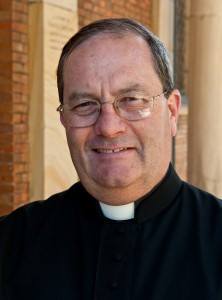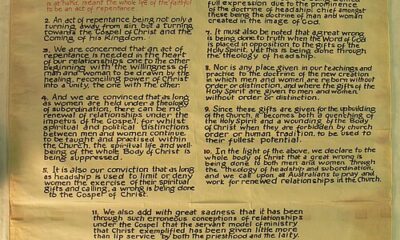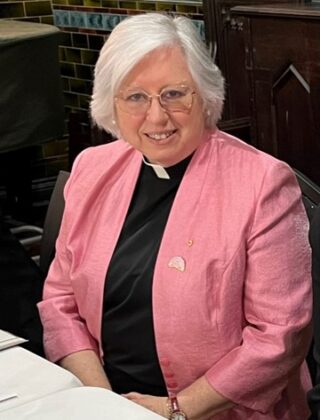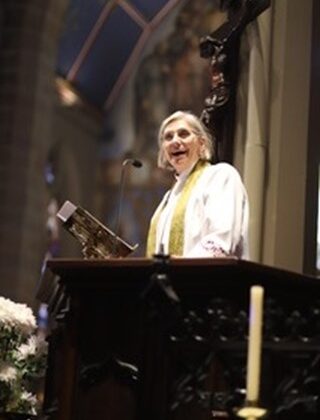Sydney MOW AGM 2015
|

SYDNEY MOW AGM 2015

On 29 August 2015, MOW Australia Ltd and the Committee for the Sydney Movement for the Ordination of Women (Sydney MOW) held our AGM’s at St Luke’s Anglican Church in Mosman, NSW.
Our guest speaker was the Rev. Andrew Sempell, BA, BTh. Dip Min., Rector of St James, King Street.
As rector of one of Sydney’s leading high church parishes since 2010, Andrew has been willing to discuss some of the controversial issues in the Anglican church of our day.
Andrew’s address: “Fathers, Heretics and the Failure of Mission” can be downloaded by clicking on the link: “Fathers, Heretics and the Failure of Mission”
AN ADDRESS TO THE
MOVEMENT FOR THE ORDINATION OF WOMEN ANNUAL GENERAL MEETING
“Fathers, Heretics and the Failure of Mission”
The Reverend Andrew Sempell
Rector of St James’, King Street, Sydney
29th August, 2015
I thank the organisers of today’s meeting for inviting me to give this address. It is a delight to be with you and have this opportunity to think about the church, its mission and the current status of women in this context.
Mission
When I was young, growing up in the Glenorie / Dural area north-west of Sydney, I got to know two families that were involved with the Wycliffe Bible translators, operating in PNG. One of them, Tom Webb, lent me a pamphlet on the work of missionaries and the anthropology that informs it. What struck me about the approach described (regardless of the religious tradition) was a number of underlying principles:
- The need to be generous and outwardly focussed toward the needs of others before seeking to address the needs of the self or the institution,
- The requirement to learn the culture and its language and be changed by it (thereby gaining respect), before seeking to influence or teach,
- The importance of enculturation of the gospel, which is the framing of the message in terms of the local culture rather than a foreign one, and
- The empowerment of local people to lead and shape the new church construct (whatever it may be) so that it becomes their own.
This tract had such a profound impact on me at the age of eighteen that I can still remember it. What struck me most, was that it described an approach to being church that was a world away from the local parish of which I was a member. This model of mission recognised and embraced openness, vulnerability, an acceptance of change, and a desire to engage equally with others rather than dominate them or protect territory. It has shaped much of my attitude to ministry since.
Churches, like most institutions, are by their nature inward-looking organisations principally concerned with their own welfare. It is not surprising that this would be the case, for much effort and resources are deployed in maintaining their structure and activities. The church, however, should be bigger than this; for it is not just the denomination, the institution, or the local congregation.
1
Instead, I would propose that the church is a community of faith called by God into mission. As the Gospel of John suggests, it is not that we chose God but that God chose us and gave us the task of bringing his love into the world (John 15:16-17). We are diverse and often fractured, but we are stuck with one another; and we also need one another – for that is the nature of true community.
This situation is ‘writ large’ in the story of the people of God in the Old Testament, who were meant to be ‘a light to the nations’ but were too often more concerned about themselves and the sectional interests within the nation. God regularly sent prophets to call them back to faithfulness and mission, but it was not an easy task. On several occasions drastic consequences followed because of the unfaithfulness of the people. The narrative remains as a warning to us all of the outcomes of a failure of mission – a warning relevant to our own times.
Mission, I would contend, is multidimensional, relational, dynamic, and sacramental – for it is about an encounter with God both individually and corporately. Yet this, too, seems to be a world away from what presents itself as church today and even as church down through history. So let’s go back to the beginnings.
St Paul in Mission
I must admit, the common image of St Paul presented in our own times is not one with which I find much resonance. I can recognise the concerns about misogyny and chauvinism that people claim are present in his writings, nevertheless I don’t think that this is the basis for his teaching or preaching of the gospel. Rather, it is an expression of the nature of the culture of his day.
Paul was a Greek-speaking Jew from Asia Minor who plied the trade of tent making. His letters are written in Koine, or “common” Greek, which indicates that he was educated but probably not well off. He was also a member of the Jewish Pharisee sect, which was concerned with living a strict religious life. He developed a strong mission to the Gentiles that created difficulties for Jewish Christians, who thought that Gentiles must become Jews first before joining the Christian movement.
Although there are moments in his writings where he ordered that women should be silent (1 Corinthians 14:34–36), it is nevertheless clear that women played a large part in his work. Examples are Chloe in Corinth (1 Corinthians 1:11) and Phoebe a deacon and benefactor sent by Paul to Rome (Romans 16:1–2). Indeed, many other women are recorded as being in church leadership, including Junia (who was possibly considered an apostle), Mary and Julia. So the writings of Paul also support the view that women should have leadership roles in the church.
Paul was also a social radical in his inward beliefs, as we read in his equalitarian words to the Galatians;
2
“There is no longer Jew or Greek, there is no longer slave or free, there is no longer male and female; for all of you are one in Christ Jesus” (Galatians 3:28)
But he was a social conservative in his outward behaviour telling slaves to obey their masters and wives to submit to their husbands (Ephesians 5 & 6).
The mistake here is to say that every sentence of Paul’s letters are of equal value or are written with the intention of being ‘holy writ’. He shapes his ideas and behaviours to fit into the context where he finds himself. Indeed, he admits it himself;
“Though I am free and belong to no one, I have made myself a slave to everyone, to win as many as possible. To the Jews I became like a Jew, to win the Jews. To those under the law I became like one under the law (though I myself am not under the law), so as to win those under the law. To those not having the law I became like one not having the law (though I am not free from God’s law but am under Christ’s law), so as to win those not having the law. To the weak I became weak, to win the weak. I have become all things to all people so that by all possible means I might save some. I do all this for the sake of the gospel, so that I may share in its blessings”. (1 Corinthians 9:19-23)
In a similar vein, the account of Paul’s visit to Athens in Acts 17 is example of where he steps into the local culture and uses local images and ideas to engage the people. There was no point speaking to them as if they were Jews!
Paul then was a pragmatist, who used whatever was is at his disposal to achieve an outcome. Nevertheless, there are risks with this approach, for it can easily segue into allowing the ends to justify the means – as I believe some of his present day followers do. Paul is more a model for practical ministry rather than a systematic theologian. In this respect he was a successful missionary following the principles I mentioned at the beginning. So what went wrong?
Fathers and Heretics
The early church fathers, following their Jewish and Greek antecedents, struggled with the status of women in society and the church. Rather that reflecting the radical views of Jesus or Paul, they were content with the social norms of the day – and perhaps a little worse. Much of the struggle in the development of early doctrine, as the creeds demonstrate, centred on the nature of Christ as being both human and divine.
I don’t perceive that this is a very contentious issue in the academies today, but it was then because of the religious and philosophical influences of the day that could not conceive of the divine and human essences mixing in the one person.
One reason for this was the Jewish view that people are ‘born in sin’, transferred to them through the act of childbirth. Women were therefore part of the problem, being the
3
carriers of uncleanness and sin. It was therefore a very radical move for God to enter the world as a human born of a woman. Mary, the Mother of our Lord, is therefore a very ambiguous character in the Jesus narrative – an unclean woman on the one hand, but the bearer of God in humanity on the other. The solution was to elevate her beyond the grasp of humanity and hold her up as an icon of eternal obedience – thus perfection, silence and submission all rolled into one.
So what did the early church fathers say about women?
The worst was probably the second / third century writer Tertullian of North Africa, who described women as ‘a temple built over a sewer’. His contemporary Clement of Alexandria was not much better, and so it went on into the third century with Origen who dismissed even the wise words of a woman simply because ‘they came from the mouth of a woman’.
Even yesterday we commemorated the fourth / fifth century bishop Augustine of Hippo (354-430) who wrote;
“What is the difference whether it is in a wife or a mother, it is still Eve the temptress that we must beware of in any woman… I fail to see what use woman can be to man, if one excludes the function of bearing children.”
(De genesi ad litteram, 9, 5-9)
These were the men that established and led the early Christian church, laying the foundations of what was yet to come. On the one hand, they merely reflected the spirit of the age, but on the other hand they created an institutional culture that failed the liberating and transforming spirit of the gospel. It continued in the middle-ages with Thomas Aquinas (1225-1274):
“As regards the individual nature, woman is defective and misbegotten, for the active force in the male seed tends to the production of a perfect likeness in the masculine sex; while the production of woman comes from a defect in the active force or from some material indisposition, or even from some external influence”.
(Summa Theologica I q. 92 a. 1)
It also continued with the reformers, such as John Knox (1513-1572), who wrote a tract called The First Blast of the Trumpet Against the Monstrous Regimen of Women, in which he argued that “God, by the order of his creation, has not given women any authority or dominion” and that historically “man has seen, proved, and pronounced just causes why it should be”. In other words, women should have no authority in any sphere of life, over men. It did not go down well with Queen Elizabeth I, who decided to keep this particular nasty protestant influence out of England.
The term ‘heretic’ is a very versatile one that can refer to almost any other person with whom I disagree. Heresy has always been a big deal in the life of the church, but it was
4
especially so in the first four hundred years of its existence as it sought to work out what it really believed. Remember, that this was a time when the church grew rapidly across many national and cultural boundaries. It therefore faced many challenges in incorporating the diverse world-views of Jerusalem, Athens, Rome, Alexandria and Babylon. It was also an era when religion and faith (of whatever sort) was important for the ordering of society.
It would seem that the Fathers of the church were not preachers of ‘good news’ for women. Yet, for many of a conservative bent they have become a bulwark against change and growth. Churchmen still hide behind them today, arguing that they are the only sources of orthodoxy and a true interpretation of the gospel; but the times have changed and traditional religion no longer provides the dominant way of understanding or shaping the world.
The Failure of Mission
In times of change the natural inclination is to try to keep things under control. The past 200 years has seen rapid technological and social change, – sometimes good, sometimes bad. One thing that emerged from this Enlightenment Era was a greater desire to see justice prevail. The abolition of slavery, the rise of women’s rights, the fight against racism, and the creation of bodies such as the United Nations and the International Courts of Justice are all signs of this. Christians have been major players in achieving many of these things, but there have also been reactionary movements in the church that have sought to deny these improvements.
A visit to South Africa earlier this year was instructive in this regard. At the Conference I attended we learnt about the former apartheid policies. A number of Christian churches supported this policy, the principal one being the Dutch Reformed Church. Its support for racial segregation grew out of its Calvinist roots and beliefs in its being a predestined ‘community of the elect’ chosen and blessed by God and desire to establish a devout Christian community based on the supposed ‘plain reading’ of the Bible. Yet, black and coloured South Africans entered the Christian faith through other churches. Most of these were critical of the apartheid regime and they became catalysts for change. The South African Council of Churches actively opposed apartheid and allowed church leaders, such as Desmond Tutu, to be more outspoken in their opposition to the government.
But back to the bigger story. In the late nineteenth century, some elements in the Protestant churches began to react to the secular world-view and its influence upon theology. In response, they developed an insistence on a literal reading of the Bible as historical fact, which included literal Creationism. Around the years 1910-15, a number of articles, essays and arguments were collected into a series of books entitled The Fundamentals: A Testimony to the Truth. This gave rise to the term ‘Fundamentalist’, especially regarding those who argued for such a position. This term is now a pejorative
5
one, used to refer to someone who takes a rigid view on some matter and who is both intolerant of, and refuses to engage with, those who take a differing view. Religious fundamentalism (of all brands) has proven to be retrograde to the welfare of women.
This is the environment in which complementarianism has arisen. It is a view that men and women have different but complementary roles and responsibilities in marriage, family life, religious leadership, and elsewhere. In many respects this seems logical until, like John Knox, it is extended universally. Hardliners, following Knox, argue that women’s subordination is biblically-prescribed. Thus leadership roles belong to men and support roles to women. This position is based on a literalist reading of St Paul, through the eyes of the Church Fathers, that denies the possibility of social change. It is also a reminder of the failure of the church’s mission in our own times.
A friend of mine once used the phrase ‘rowing into the future’ to describe (in this instance) the practices of church schools in Australia. Not being a rower, I was unsure what he meant, however he described how rowers are always looking backward at where they have come from rather than where they are going – indeed, they can do no other. It is a good metaphor for the church in general, for we look to the past to understand the present. It therefore makes us very conservative and can sometimes have the effect of locking us into some past defining moments in history that can be informing and identity-creating on the one hand, but can also be fixating and debilitating on the other.
The Christian Church of course focusses on the story of the people of God as recorded in the Bible and especially the defining events of the life and teaching of Jesus (including the crucifixion, the resurrection and the establishment of the early church). There are also the creeds, the church councils and other early writings. In addition to these, the Anglican Church looks to the Elizabethan Settlement, the Book of Common Prayer and the Thirty-nine Articles as some of its defining moments. What people look back to and focus on provides an insight into their motivations and agendas in the present time and how they see themselves and their relationship within society.
For the church, this is all worked out in three areas:
- Theology: which gives expression to the beliefs, ideas and hopes that shape and hold the community together, and serves as the collected memory of the experience of God in humanity,
- Ecclesiology: which provides the structure for the activity of the church and is also meant to be a reflection of what God has called us to be, and
- Practice: that provides shape and focus for the activities of the people of God, including worship, pastoral care, education and outreach.
These things change as the gospel is reinterpreted within various cultures and for different moments in time. To be sure, much of the history of the church (including our own time) has been about the struggles and challenges of change and the reshaping of
6
the church for the world in which it finds itself. Yet, like most institutions, it often comes down to matter of power, status and wealth. The processes of change have not always been a pretty sight – sometimes leading to wars, persecution and chaos. Nevertheless, considering ourselves more civilised these days, we now tend to destroy the reputations of those with whom we disagree rather than kill them.
So do we dare look forward and envision a future church? As the world faces up to the passing of the modern era, the church likewise has to consider what is appropriate for its current and future mission. This has been its major challenge since the boom-times of the 1950’s through its decline to our present time. Many programmes have been developed and applied in this time with limited success; such as the Church Growth Movement, the Decade for Evangelism, Fresh Expressions, and in Sydney our home- grown Connect 09. Yet, in the past sixty years, regular church attendance has dropped from around 50% to less than 10% of the population (of which around 2.5% are Anglican). Are we just being doggedly faithful to our perceived calling, or are we simply naïve and missing the point?
Challenges for the Churches
Judging from recent media comments, many people are losing patience with institutional religion in Australia. Rather than toleration, there is a rising anger and resentment against religious groups as evidenced in the predominantly negative reaction to Archbishop Jensen’s 2012 article in the Sydney Morning Herald on the concept of wifely submission in marriage. This negative reaction seems to occur because the churches either pick the wrong issues to pursue in the public domain or they have pursued them in the wrong way. Some examples are:
- the fight against ethics classes in state schools, such that the church appears to be against the teaching of ethics (and by extension unethical);
- the attitude toward women in parts of the church, with the implication that they are not permitted to take positions of leadership because they are considered subordinate to men;
- the desire to maintain discriminatory practices in church run schools, hospitals and other institutions that run contrary to community standards;
- church attitudes toward human sexuality, and
- the failure of churches to address child abuse in an appropriate manner.
As in any relationship, manipulation, bullying, discrimination, and betrayal of trust are some of the most difficult things from which to recover and grow. These matters will hang about the churches for many years to come and inhibit its mission. A major part of our current situation then, is to seek reconciliation with the wider community and once again be accepted as a force for the good of society. It may also require a new reformation!
7
Appendix 1 RESPONSE TO THE SYDNEY DIOCESE’S PECULIAR MARRIAGE VOWS
The Anglican Diocese of Sydney is a peculiar organisation with an equally peculiar understanding of the Christian faith and the world in which it operates. Now by ‘peculiar’, I mean the older and more nuanced definition of being ‘special or unique’ (as used in 1 Peter 2:9); however most people will understand the word in its newer form as ‘strange or odd’.
Recent events in Sydney are providing a good lesson on the importance of language and the effects of semantic shift. The word ‘submission’ has a variety of meanings that have changed over time and carry a good deal of cultural baggage. The Oxford Dictionary defines submission as: ‘the action of accepting or yielding to a superior force or to the will or authority of another person’. So in the case of the proposed marriage vows it implies the position of a wife yielding to ‘the superior authority of her husband’. Now this may be exactly what the Liturgical Panel means and wants to achieve, I’m not sure; however it is clearly offensive to the majority of the Australian public and indeed reflects a minority view within the Anglican Church itself. Understandably, critics have pointed out that the proposed vows suggest a form of domestic slavery.
On the other hand, there has been a good deal of re-defining and explanation of what the word ‘submit’ actually means in its context; arguing that there is no suggestion of misogyny or any intention to demean the role of women in marriage (or even in the Diocese at large). In other words, the Sydney Morning Herald and other commentators have misunderstood what was intended and taken the word out of context. It is also noted that this is currently a ‘proposed’ form of service and that there may be some legal implications that need to be resolved before it can be used legitimately.
A Bible passage to which proponents of the new vows point is Ephesians 5:22-24: ‘Wives, be subject to your husbands as you are to the Lord. For the husband is the head of the wife just as Christ is the head of the church, the body of which he is the Saviour. Just as the church is subject to Christ, so also wives ought to be, in everything, to their husbands’. The Letter to the Ephesians contains similar injunctions for both children and slaves. It is good to ask what St Paul actually meant by these words and as to whether they apply to us today. Much of the church side of the debate has centred on this issue.
In an effort to gain a perspective on the possible social impact of this proposal it is first necessary to look at some data. According to the Australian Bureau of Statistics, the number of couples seeking a religious ceremony has dropped markedly over the past 20 years. Nationally, the Anglican Church currently conducts around 5% of marriages annually. With respect to the Diocese of Sydney, around 1.5% of marriages in Australia are conducted by its clergy. The proposed vows are only an option for couples to take and many would obviously choose not to. So it might be construed that, at best, around 0.5% of Australian couples might avail themselves of the proposed vows, which indicates that their impact is extremely marginal at best and one may well wonder why the wider community has taken any interest in the matter. However, there may be some other issues at stake here.
8
Three important aspects in the business of theology are the discerning of WHAT we believe, HOW we believe it and WHY. All of this is done within a context that is influenced by our understanding of God, humanity and the nature of the world in which we live. Theology seeks to bring these things together and help us to make sense of it all.
Within the Anglican Communion, the Diocese of Sydney is understood to have some particular ways of addressing the business of theology. The Diocese sees itself as being conservative and orthodox in its theological views, (to be sure: ‘reformed, evangelical and protestant’), yet it is also aware that it is at variance with the wider Anglican Church on many matters. Some argue that the Diocese is ‘fundamentalist’ in its approach to theology and more especially in its interpretation of the Bible. This may somewhat overstate the case, nevertheless it would seem that parts of the Bible are often read in a literalist and prescriptive manner that takes little account of the social, political and philosophical influences that shaped its development at the time.
Relying on its particular hermeneutic (method of interpretation), the Diocese claims that it is ‘Bible believing’ and suggests by implication that those who disagree with it or that use a different hermeneutic are not. Thus, people and churches are determined as being either in the group that follow Biblical Truth (as it is understood in the Diocese) or outside this Truth and therefore are either ‘confused’, ‘lost’ or even ‘sub-Christian’ (if from a suspect Christian grouping). This approach is at risk of becoming self- referencing and therefore impervious to external criticism. The Diocese’s attitude is therefore often perceived as aggressive, arrogant and judgemental by those who fall outside its view of orthodox. On the other hand, one must admit that being assured, confident and discerning are indeed strengths, but they become weaknesses when they are overdone.
Now, I state clearly that I do not charge the Archbishop with these failings, for I know him to be a gracious man who is ambitious only for the spread of the Gospel; as are many others in the Diocese. However, the Diocesan institution over which he presides is often perceived in the negative terms described above and recent events have served to reinforce these views in the public arena. Is there a lesson to be learnt here?
For the past ten years the Diocese has been focussed on its Mission to have 10% of the population worshipping in ‘Bible believing churches’ by 2012. While this may have been more of a PR exercise rather than a realisable goal, it is interesting to note that (according to Diocesan statistics) an average of around 1.2% of the Sydney population
9
worships in an Anglican church on any Sunday. Given people’s irregular worship habits, if we double this figure there would still only be 2.4% regular worshippers. The Anglican Church is therefore very marginal to the life of the wider community.
This marginalisation is perhaps reflected in the responses to the Archbishop’s article on different vows for men and women. Around 1,000 comments were recorded on the Sydney Morning Herald site, (not to mention letters to the editor and other blog-site comments), most of which were negative. However, the Archbishop’s article was predictable and sought to defend the Diocese’s position in the face of the public reaction to a series of newspaper articles in the previous week. What shocked many was the volume of these responses and the contempt expressed in most of them. Yet many of these are the voices of people with whom we seek to engage in mission and who can tell us why we fail.
The problem with this public debate concerning marriage vows is that it has had a retrograde impact on the reputation and mission of the church. The church needs to understand that it is now a minority group located in a community that is becoming less tolerant of its idiosyncrasies and any sense of theological obscurantism. Indeed, the church has to win the respect of the community once again if it wants to be heard among the many voices that vie for the public ear.
We talk in terms of relationship when it comes to mission and evangelism, and this is the model that needs to be used in public debate. There is no room for dogmatism or dismissiveness of those with whom we disagree. We need a positive attitude toward those with whom we seek to engage, we need to appreciate the culture in which we are located and work with it, we need a humble approach to the concept of truth, and we need to use language wisely if we are to develop any meaningful dialogue.
The Reverend Andrew Sempell,
Rector of St James’ Church, King Street, Sydney. 30 Aug 12 2015











